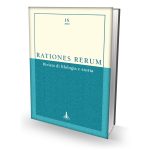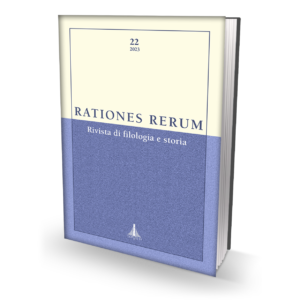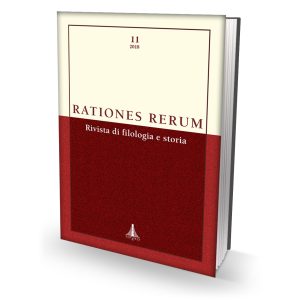RATIONES RERUM 16 – Rivista di filologia e storia
50,00 €
Autori vari
Anno edizione: 2020
Formato 17×24 – Pagine 484
Confezione a filo refe in brossura
Copertina plastificata con bandelle
ISBN 9788899846527 – ISSN 2284-2497
Prezzo: € 50,00
- Descrizione
- ANTEPRIMA
- ABSTRACTS
Descrizione
Per SCEVOLA MARIOTTI nel centenario della nascita
Sommario
Leopoldo Gamberale, Premessa, p. 9
Rino Avesani, Se il grammatico Bartolomeo da Sulmona sia da identificare con il suo omonimo e contemporaneo vescovo di Valva e Sulmona, p. 11
Francesco Bausi, Tracce di diacronia e di pluriredazionalità nel Decameron, p. 27
Paolo Chiesa, Ab Agustino papa. Un inedito commento figurale a Tobia, p. 47
Claudio Ciociola, «Filologismo»: discussioni nel Novecento italiano, p. 73
Carmen Codoñer, Etymologiae: un problema más. Capítulo 2, 21, p. 115
Franca Ela Consolino, L’ebbrezza di Noè e l’incesto di Lot nel Carmen de virginitate di Aldelmo (vv. 2501-2524), p. 157
Michele Feo, Il sogno erotico di Penelope (Epigr. Bob. 36, 13-14), p. 177
Stefano Grazzini, Una banalizzazione persistente: nota a Serv. ad Aen. 7, 490, p. 183
Isabella Gualandri, Derivatio in Macrobio, Sat. 6, 1, 2: una proposta d’interpretazione, p. 189
Gregory O. Hutchinson, L’apertura, p. 205
Robert A. Kaster, Notes on Seneca, De beneficiis 7, 19, 5 – 7, 31, 2, p. 223
Giuseppina Magnaldi, Parole-segnale e sigla nel De ira di Seneca, p. 243
Ermanno Malaspina, Lupo e “Adoardo” nel Lucullus di Cicerone: congetture carolinge e tradizioni perdute nel Corpus Leidense?, p. 251
Marco Mancini, Lat. issula in Plauto e l’assimilazione del gruppo -ps- nel latino parlato, p. 289
Marc Mayer i Olivé, Tres notas textuales sobre Catulo: 38, 1-2; 39, 19; 116, 1, p. 321
Roberto Palla, I due Gregori (ed altro). Note testuali a Greg. Naz. Carm. II 2, 3, 229-245, p. 335
Costas Panayotakis, Pomponius’ Atellane comedy Lar familiaris (Prisc. Gramm. II 213) and the sexual neologism vaso (61 R3 = 57 F2), p. 345
Oronzo Pecere, La revisione “in coppia” di due esemplari tardoantichi di Orazio e Marziano Capella, p. 363
Marco Petoletti, La lettera di Giovanni Dondi dall’Orologio al veronese Gasparo Squaro su Seneca, Epistulae ad Lucilium 7, 3-5, p. 381
Michael D. Reeve, An et in Virgil: Georgics 3, 157-165, p. 411
Elisa Romano, “L’amico di Servilio” (Ennio, Ann. 268-286 Skutsch), Plinio il Giovane e la fortuna di una congettura, p. 427
Christoph Schubert, Volup est. Heitere Anthropomorphismus-Kritik bei Arnobius, Adversus nationes 7, 34, p. 443
Claudia Villa, Reparari / separari: la verità di un testimone (per Accursio Bonfantini e Dante, Inf. 13, 103-108), p. 461
Abstracts, p. 469
Indice analitico (a cura di Carlo Di Giovine), p. 477
Istruzioni per gli autori, p. 483
Rino Avesani
Se il grammatico Bartolomeo da Sulmona sia da identificare con il suo omonimo e contemporaneo vescovo di Valva e Sulmona
pp. 11-25
This article focuses on the identification of the grammarian Bartolomeo of Sulmona – known as Bartholomeus Philalites from his Institutiones grammaticae – with the coeval and homonymous Dominican bishop of Valva and Sulmona. The present study shows that this identification is erroneous, as Carlo De Frede argued in 1960, although on the basis of a non-determinative argument. Cristiano Nodari reaches the same conclusion in his research for his forthcoming critical edition of the Institutiones grammaticae. The definitive evidence comes from a letter by the nephew of Pope Pious II, Card. Francesco Tedeschini Piccolomini, who thanks the grammarian Bartolomeo for having defended the memory of his uncle from the tirades of Francesco Filelfo.
Francesco Bausi
Tracce di diacronia e di pluriredazionalità nel Decameron
pp. 27-46
This article examines the possibility that the Decameron had more than one version, not in terms of the variant readings found in the different manuscripts, but in terms of the structure and internal diachrony of the work. To this end, some specific types of clues are taken into consideration: structural aporias of a general nature, narrative contradictions and other incoherencies within the single tales, and cases of imperfect correspondence between headings, preambles and tales. From these elements it is possible to formulate deductions relating to the editorial history of both the Decameron as a whole (identifying at least three phases), and of some of the tales (which were probably composed independently prior to the Decameron project and then were successively subjected to revision and adaptation when Boccaccio decided to include them in the book).
Paolo Chiesa
Ab Agustino papa. Un inedito commento figurale a Tobia
pp. 47-71
This article provides a critical edition of the commentary on the biblical book of Tobias preserved in ms. Paris BnF lat. 15679 (an exegetical miscellany embracing the entire Bible, under the auspices of a project by Theodulphus of Orléans, d. 821). The exegetic interpretation is strictly allegorical, in a fashion unusual for the book of Tobias in the early Middle Ages; several clues suggest that the work was in fact composed before the Carolingian age. The title of the commentary in the manuscript attributes the text to the teaching of Augustine of Hippo; however, both the low stylistic level and some doctrinal awkwardness prevent the uncritical acceptance of such an assumption.
Claudio Ciociola
«Filologismo»: discussioni nel Novecento italiano
pp. 73-114
This article examines the history of the concept of “philologism” in Italy, from its origins to the present day, highlighting how over the decades the term (together with its derivatives) has been understood and used in different ways, in a dialectic with the basic concept of “philology” and within several disciplinary fields (Romance, Italian and classical philologies). This combining of the history of philology, linguistic history and historical semantics aims to present and analyze the positions of scholars with nodal roles in history of philology in Italy during the 20th century.
Carmen Codoñer
Etymologiae: un problema más. Capítulo 2, 21
pp. 115-156
Chapter 2, 21 of Isidore of Seville’s Etymologiae reaches us in two versions: a short one (2, 1-2) and a long one (2, 1-48), transmitted by two families of manuscripts whose provenance is clearly different—from Italy and from Spain. The study of its structure is followed by a comparative analysis of Isidore’s chapter with its version in the Anonymus Ecksteini, and with the part of the chapter integrated in Isidorus Iunior’s De uitiis et uirtutibus orationis. This comparative analysis, together with the verification of which 2, 21 entries do or do not belong to the Liber Glossarum, yields some conclusions about authorship.
Franca Ela Consolino
L’ebbrezza di Noè e l’incesto di Lot nel Carmen de virginitate di Aldelmo (vv. 2501-2524)
pp. 157-175
The two passages (vv. 2501-2524) of Aldhelm’s Carmen de virginitate on the drunkenness of Noah and the incest of Lot, which have not so far received scholarly attention, are the subject of a detailed analysis comparing them with biblical narration and demonstrating their relationship with Christian and profane literary traditions. It turns out that the passages’ adaptations from previous poets are generally detached from their original contexts, except for the reference to the poet of the Heptateuch in the episode of Noah’s drunkenness. In this case, Aldhelm establishes a precise relationship of continuity with the biblical epic, but he departs from it by finalizing his story with the moral teaching that is derived from it, following a tendency already typical of Christian homiletics and paraenesis. All in all, the treatment of the exempla on drunkenness shows how Aldhelm receives in a non-passive way Patristic teachings and the legacies of classical and, above all, late antique Latin poetry.
Michele Feo
Il sogno erotico di Penelope (Epigr. Bob. 36, 13-14)
pp. 177-182
The critical text of Epigr. Bob. 36, 13 is not certain. Penelope says, in an erotic dream, that she did not ask for anyone’s help, neither from her avia, nor from a serva anus. Concerning the reading avia there are many proposed suggestions. The author, who once rejected the possibility of seeing here an echo of the anthropological custom of defending the newlywed during the first night, now asserts the correctness of the reading aviam in the ancient editions, as it reflects similar poetic situations in Ov. Met. 10, 382-384, and Tib. 1, 3, 89-92.
Stefano Grazzini
Una banalizzazione persistente: nota a Serv. ad Aen. 7, 490
pp. 183-188
In their editions of Servius’ commentary ad Aen. 7, 490 (which includes Virgil’s description of Silvia’s pet stag) both Thilo and Ramires kept the reading dominum, here to be interpreted as synonymous with erus. An alternative understanding of the text, in which dominum is replaced with hominum, was suggested by Rabbow and accepted by Friedrich in his entry erus for the ThlL. Despite having been neglected by later scholarship, this suggestion seems compelling insofar as it accounts for the nouitas of the phrase, beside being attested by two important Servian codices. A further confirmation is provided by Servius himself in another passage of his commentary (ad Aen. 7, 278), where the same phrase non nisi hominum is referred to monilia.
Isabella Gualandri
Derivatio in Macrobio, Sat. 6, 1, 2: una proposta d’interpretazione
pp. 189-203
In his critical discussion of Vergil’s imitations of earlier Latin poets, Macrobius (Sat. 6, 1, 2) argues that one of the benefits of reading is «to make use opportuna derivatione of what you most admire in other authors». While derivatio is here usually explained in a broad sense (viz. “taking inspiration from a text and borrowing something from it”), this article, by examining some of the parallelisms between Vergil and Ennius listed by Macrobius, aims at connecting it with the more definite meaning which can be inferred from Quintilian (Inst. 3, 7, 25)—i.e., “change of words”.
Gregory O. Hutchinson
L’apertura
pp. 205-221
The act of opening a box, door, etc. was important to ancient practical life; poetry exploits it forcefully, and with rich psychological and theological significance. Spring is often connected with opening (so Alcaeus, Pindar, Ovid). Scenes of opening, and not opening, are important in the Odyssey and Parmenides, in drama (Agamemnon, Ajax, Medea, Heracles, Ion, Clouds, Ecclesiazusae, Curculio), in Hellenistic poetry (Apollonius, Theocritus, Grenfell Fragment), and in Roman poetry (Odes, Amores, Aeneid). Chests and boxes can contain memories and link to the opening of emotions; drama interests itself in revealing closed thoughts, secrets, and events. Door-scenes dramatize the conflict of wills in plays and poems on love. The drastic interventions of the gods are manifested and expressed through opening.
Robert A. Kaster
Notes on Seneca, De beneficiis 7, 19, 5 – 7, 31, 2
pp. 223-241
Emerging from the preparation of a new critical edition of Seneca’s De beneficiis for the Oxford Classical Texts series, this paper reviews a dozen passages from the closing chapters of Book 7. In most cases, the paper argues for a text different from that found in the now-standard reference edition of Carl Hosius (Teubner 2nd ed., 1914); where Hosius’ choice is preferable to the alternatives available, there is some value to be found in making plain why it is preferable. At or near the end of each note there is an English translation of the problematic portion of text, clarifying how the passage should be understood.
Giuseppina Magnaldi
Parole-segnale e sigla nel De ira di Seneca
pp. 243-249
This article identifies four ancient emendations in the transmitted text of Seneca’s De ira. The constitutio textus by Gertz is accordingly defended for 2, 31, 4; a new constitutio is advanced for 1, 16, 4; 2, 8, 3; 2, 32, 1.
Ermanno Malaspina
Lupo e “Adoardo” nel Lucullus di Cicerone: congetture carolinge e tradizioni perdute nel Corpus Leidense?
pp. 251-288
This article addresses the relationships between the correctors of the three main manuscripts of Cicero’s Lucullus (BAV), to establish whether there are traces of independent traditions or rather, as it is believed, of horizontal contamination. Firstly, the status quaestionis on the stemma of the Corpus Leidense and the dates of the manuscripts is outlined, highlighting the problematic position of A and V as twins, supposed by most editors. The article then analyses the methods of correction of “Hadoard” – to whom we owe the B2A2 phases and the descriptus F – and of Lupus with V. It is shown that in some loci Lupus also could have used the collation of a lost manuscript (Vm). Finally, concerning the F>V contamination postulated by Schmidt, the approximately 170 correspondences prove in fact to be orthographic corrections and/or good conjectures, independent products of the ingenium of both scholars. Moreover, the 13 residual erroneous coincidences prove to be polygenetic, while in no case does Lupus seem to have had the integrations to V present in F at his disposal. In the evaluation of the horizontal contamination, in conclusion, we must not be misled by the numerical data and recognise that the Carolingian correctors could have independently produced the same interventions and the same corrections in the text.
Marco Mancini
Lat. issula in Plauto e l’assimilazione del gruppo -ps- nel latino parlato
pp. 289-319
The –ps– > –ss- regressive assimilation is admittedly part of a general weakening drift of syllabic codas in Late Latin, as in the cases of –kt– > –tt– / –xt-, –ks– > –ss– and so forth. The early Plautinian noun issula “mistress” (< ipsula) in a corrupt passage of Cistellaria (v. 450) is traditionally interpreted as the very first occurrence of this well-known Vulgar Latin phenomenon (cf. Ital. esso, scrisse etc.). After a thorough inspection of all the available evidence, both in the inscriptions and in the literary texts, three points should be underlined. First, on the grounds of relative chronology, such an early occurrence of this assimilation (III BC) is implausible. Secondly, the overwhelmingly attested late <s>-spellings from –ps– must be traced back to a typical use of the Latin scripta, namely the “deletion” (Lat. demptio) of the “implosive” letter, see e.g. Quintilian, Inst. 1, 7, 29, on Lat. columna. Thirdly, within the outlined context a <ss>-spelling is clearly deviant from the overall orthographic norm: it systematically occurs only in the case of Lat. isse, issus etc. This leads to a new hypothesis: these forms (and only these) were the result of an early morphological reinterpretation in the light of a diagrammatically iconic pseudo-etymology: ipse → is-se / is-sus (whence is-sa, is-sum). A surprisingly similar reinterpretation is attested in a famous Ciceronian passage on Nom. Sing. īdem → isdem (Or. 157).
Marc Mayer i Olivé
Tres notas textuales sobre Catulo: 38, 1-2; 39, 19; 116, 1
pp. 321-333
This article discusses three alternative readings in the text of Catullus in place of those normally accepted by editors: 38, 1-2; 39, 19; 116, 1. It also examines the possibility that some of them are author’s variants.
Roberto Palla
I due Gregori (ed altro). Note testuali a Greg. Naz. Carm. II 2, 3, 229-245
pp. 335-343
This article analyses a passage from Gregory of Nazianzus’ poem Πρὸς Βιταλιανὸν παρὰ τῶν υἱῶν (Carm. 2, 2, 3, vv. 229-245). A thorough examination of the entire manuscript tradition points to modifications at some points in the text as commonly accepted by editors and scholars.
Costas Panayotakis
Pomponius’ Atellane comedy Lar familiaris (Prisc. Gramm. II 213) and the sexual neologism vaso (61 R.3 = 57 F.2)
pp. 345-361
This article reconsiders a hitherto neglected fragment that Priscian (6, 21 = Gramm. II 212, 23 – 213, 6 Hertz) attributes to a play by the Atellane playwright Pomponius entitled Lar familiaris, “The Household-God”. First, it discusses the grammatical context of the fragment (concentrating on the noun lactes “small intestines”), the title of the play, and the content of the fragment (including the comic supplication of the unnamed speaker). It then focuses on the textual problems surrounding the sexual term uaso (OLD s.v. “one having a large male sexual organ”), which is otherwise unattested in extant Latin literature, and which is, in fact, Otto Ribbeck’s imaginative emendation in his attempt to make sense of the difficult manuscript readings in Priscian’s text. Finally, an emendation and a reading of the fragment are proposed, based on an entirely new examination of Priscian’s early medieval manuscripts.
Oronzo Pecere
La revisione “in coppia” di due esemplari tardoantichi di Orazio e Marziano Capella
pp. 363-380
This article focuses on two subscriptiones that have been transmitted by some manuscripts containing works of Horace and Martianus Capella. The subscriptiones attest to the use by the rhetor Securus Melior Felix for the text’s emendatio of (a) a copy of Horace’s lyric compositions belonging to Vettius Agorius Basilius Mavortius (consul in 527 AD), and (b) an exemplar of Martianus Capella, probably written in 534, for the teaching activities that the rhetor performed in the school of Porta Capena in Rome. Such evidence of editorial activities during late antiquity allows us to reconstruct aspects of the first steps (the ‘proto-history’) of the text of the two authors.
Marco Petoletti
La lettera di Giovanni Dondi dall’Orologio al veronese Gasparo Squaro su Seneca, Epistulae ad Lucilium 7, 3-5
pp. 381-410
A close friend and correspondent of Petrarch, Giovanni Dondi dell’Orologio († 1388), physician and scientist, left a group of letters surviving only in the MS Venezia Biblioteca Nazionale Marciana lat. XIV 223 (4340). One of them is addressed to another friend of Petrarch, Gasparo Squaro de’ Broaspini from Verona. Here Giovanni Dondi, urged by Gasparo’s request, offers an accurate explanation of a passage of Seneca (Ep. 7, 3-5), which was quite obscure to Gasparo. Moreover, Dondi adds some reflections about the variae lectiones of this passage that he found in different witnesses. After a detailed introduction concerning Giovanni Dondi’s letter collection and its cultural background, there is provided the first critical edition of Dondi’s letter to Gasparo Squaro, with some observations concerning the 14th century manuscript transmission of Seneca’s Epistulae ad Lucilium.
Michael D. Reeve
An ‘et’ in Virgil: Georgics 3, 157-165
pp. 411-425
Though a question remains about Virgil’s familiarity with branding farm animals, the et transmitted at Georgics 3, 159 is shown to accord with his stylistic habits, whereas the conjecture si, entertained in 1788 and proposed anew by the latest editor, does not. Other passages additionally discussed include Georgics 3, 319, Aeneid 2, 599-600, Aeneid 6, 882-883.
Elisa Romano
“L’amico di Servilio” (Ennio, Ann. 268-286 Skutsch), Plinio il Giovane e la fortuna di una congettura
pp. 427-441
Otto Skutsch provided a successful conjecture (iucundus for the transmitted facundus) for line 280 in the best-known quotation of Ennius’ Annals, the so-called fragment on the “friend of Servilius” (268-286). This correction, together with other evidence, is discussed in the context of a passage of Pliny the Younger (Epist. 2, 13, 5-6). This article aims to shed light on some aspects of the reception of this passage by Pliny the Younger, who in his letters seems to have recalled the verses of Ennius in some idealized portraits, and in particular in the description of some qualities that his characters share with the anonymous ideal friend depicted by Ennius.
Christoph Schubert
Volup est. Heitere Anthropomorphismus-Kritik bei Arnobius, Adversus nationes 7, 34
pp. 443-459
Just before the finale of his 7th book, Arnobius resorts to a special literary trick to get his readers in the mood for the end of the book and his argumentation against the pagan gods. In chapter 7, 34 he provides a rhetorically vibrant summary of one of his main arguments against the pagan conception of God: since the pagans had no knowledge of God’s self-revelation, they created their gods in their own image. The resulting anthropomorphic conception of God is disavowed once again in an effective reductio ad absurdum. What is special about this chapter is that Arnobius on the one hand supports the logical argument linguistically by assigning prosaic-ordinary vocabulary to mankind, but on the other hand chosen-poetic vocabulary to the gods, thus directly illustrating the process of exalting genuinely human qualities into apparent divine grandeur. On the other hand, Arnobius endows the depiction of the human world with a comic metrical scheme utilizing iambs and trochees, which signals to readers that the opponent no longer needs to be taken seriously, the time of the fierce attack is over, the burlesque has come, and they can relax and prepare themselves for the end of the book.
Claudia Villa
Reparari / separari: la verità di un testimone (per Accursio Bonfantini e Dante, Inf. 13, 103-108)
pp. 461-467
In the text of the so-called Praedestinatus, commonly assigned to Arnobius the Younger, a significant error occurs: the copyist wrote separari instead of reparari. Consequently, the idea is affirmed that souls are forever separated from the body, even after the last judgment. This idea is confirmed by Pier della Vigna in Dante Alighieri’s Inferno 13. This question was also discussed by the Florentine inquisitor Accursio Bonfantini.
















